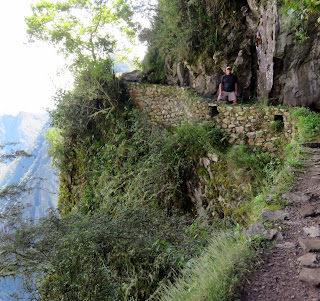
Following our visit to Sacred Valley, we woke at sunrise the next day to catch a taxi to the train station in nearby Poroy, and then spent 3.5 hours on the mid-range class, Vistadome, offered by PeruRail. The train runs alongside the Urubamba River with canyon walls on both sides, and snow-capped mountains peeking through from time to time. With large windows even in the ceiling of the train car, we had fantastic views for the trip. Our 2 suitcases were left behind with the hotel in Cusco due to luggage restrictions on the train, and we each carried a backpack for the next 3 days. Upon arrival, we worked our way through the massive market place next to the train station. Traveling to Machu Picchu Pueblo, we spent our first day exploring the village which lies below the citadel and purchasing our bus tickets and entry tickets for the next day. We were visiting during the off-season, so this was not an issue. During their busier season, train, bus and entry tickets should all be purchased ahead of time to prevent being shut out. Entry is restricted to 2500 visitors a day, so after that, you are out of luck! Tourism is the lifeblood of this community, and shops and restaurants line the streets.

Hiking to the destination is the dream of many, but even with the
reduced altitude along the Inca
Trail, the chilly nights and rough
terrain were not something we wanted to tackle. Buses leave from the terminal in Pueblo to head up the zig-zagging road at 6 AM and depart every 5-10 minutes until 4 PM. The lineup for the buses starts around 4 AM for those wanting to arrive in the park for sunrise. Or you can walk to the entrance, which takes 1.5 to 2 hours. We decided to sleep in and joined the line at a more reasonable 7 AM and waited for about an hour for our ride up. Arriving at the park a few minutes later, we still beat most of the heavy crowds created by tour groups, which arrive at 10 AM and depart by 2 PM. Spending several hours walking over the ruins, we snapped hundreds of photos, because every view was phenomenal. We did not sign up for the hike of Huayna Picchu
, the peak next door. Restricted to 400 hikers a day, and
requiring a separate ticket, this destination also provides outstanding
views (from photos we've seen) but it's a strenuous climb and we never
seriously considered it. But we covered virtually every other aspect of Machu Picchu, including the walk to the Inca Bridge. This stone path cut into the mountain cliff rises 1900 feet above the valley with a 20-foot gap, which was historically "bridged" with tree trunks. The bridge is actually closed, which is a good thing, it was scary enough just walking out to the edge.

Built around 1450 AD, the site was abandoned roughly 100 years later. The reason for the Incas leaving the site is unknown, and even the reason for its construction is only a guess. Archeologists think it was built as an estate for the Inca emperor Pachacuti. "Discovered" in 1911 by explorer Hiram Bingham, over the next few years the site was excavated by teams from Yale University and National Geographic. Of course, Hiram didn't really discover it, the locals knew it was there, they just ignored it, and the jungle had covered the structures through the centuries. It is surely one of the world's most awe-inspiring sites and is the number one tourist destination in Peru. The visit was phenomenal; we didn't want to leave and kept looking back for one more glance, one more photo.
 |
| Inca Bridge |
 |
| Looking across to Huayna Picchu |
 |
| Alan even made it out to the final narrow walk before the Inca Bridge |
 |
| On the cliff, just before the Inca "bridge" |
 Hiking to the destination is the dream of many, but even with the
reduced altitude along the Inca
Hiking to the destination is the dream of many, but even with the
reduced altitude along the Inca Hiking to the destination is the dream of many, but even with the
reduced altitude along the Inca
Hiking to the destination is the dream of many, but even with the
reduced altitude along the Inca
No comments:
Post a Comment